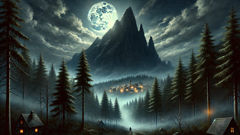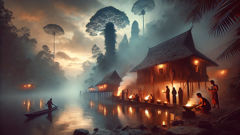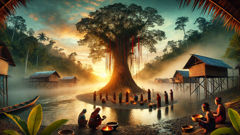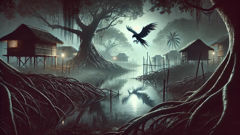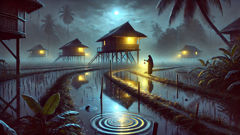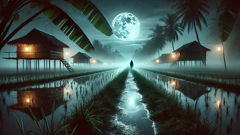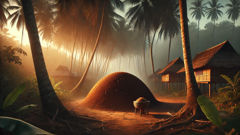Introduction
Night crept quietly over the Harz Mountains, draping the ancient forest in a shroud of purple shadows. Beneath the towering silhouette of the Brocken, Germany’s highest peak in the north, villagers huddled by flickering hearths, whispering warnings about the coming eve. It was the night before May Day—Walpurgis Night—a time when, according to whispered legend, the boundaries between worlds grew thin. The air seemed to pulse with secret energy, as if the very earth remembered every step, every ancient ritual, every echo of laughter or cry carried by the wind. In the village of Wernigerode, tucked in a hollow near the foot of the Brocken, preparations for the May Day festival mingled with nervous glances at the moonlit slopes above. Candles burned in windows, talismans hung from doorways, and children clung to their mothers’ skirts, eyes wide with excitement and fear. For centuries, folk believed that on this single night each year, witches from every corner of the land soared through the air on twisted broomsticks and gnarled branches, gathering atop the Brocken’s barren summit to dance, conjure, and pay homage to the spirits of the old world. The woods would ring with wild laughter and ancient chants, and those who dared stray too close risked being swept up in enchantments or worse. Yet, this night also promised renewal. As spring’s first green shoots pierced the last patches of snow, Walpurgis Night marked a turning—when the shadows of winter gave way to the hope and warmth of May. For some, the stories inspired awe; for others, dread. But for one young villager named Liese, the stories carried a different weight. With the recent death of her father and rumors of sickness creeping through the valley, she found herself drawn toward the forbidden slopes, desperate to understand the power lurking on the mountain and to seek hope for her ailing mother. Unbeknownst to her, fate would entwine her path with forces far older than the village, demanding courage she never imagined she possessed. As the sun set, its last rays bleeding gold across a sky soon to be filled with stars and secrets, the legend of Walpurgis Night prepared to awaken once more on the Brocken.
I. The Whispering Woods
Liese pressed her palm against the rough door, feeling the warmth of her mother’s breath on her cheek. “You mustn’t go out tonight,” whispered Frau Albrecht, her voice thin as the threadbare quilt wrapped around her. “Not with the witches abroad on the Brocken. The forest is wild on Walpurgis.” Liese nodded, but her mind was already elsewhere—drawn to the mountain, to the stories her father once told in the fire’s glow. The world outside beckoned, full of shadows and secrets.
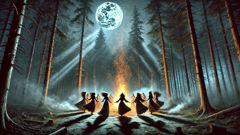
She waited until her mother’s breathing slowed, then wrapped herself in her father’s old cloak and slipped into the night. The air was cold, tinged with the scent of damp earth and pine needles. The moon rode high, nearly full, bathing the cobbled lanes in a blue glow. From every cottage, candlelight flickered behind curtains; only Liese moved between the pools of darkness.
At the village edge, she paused beside the maypole, half-finished for the coming festival, its ribbons limp and colorless in the moonlight. She remembered her father’s tales—of how the witches’ sabbath brought both danger and renewal, how they danced to chase away the winter, and how those who watched with a pure heart could sometimes glimpse the truth behind the legend. A crow croaked from a nearby branch, startling her. She gripped her cloak tighter and stepped into the woods.
Inside the forest, the world changed. The trees pressed close, branches knitting together in tangled webs that swallowed the light. Roots curled like sleeping serpents beneath mossy stones, and every rustle in the undergrowth set Liese’s heart pounding. Yet she pressed on, guided by an inexplicable pull toward the mountain.
Halfway up the slope, she caught sight of a faint glow ahead—a ring of fire flickering in a small clearing. She crept closer, keeping to the shadows. Around the flames, she glimpsed figures moving: women with wild hair and flowing skirts, some ancient and bent, others youthful and laughing, all chanting in a language older than the stones beneath their feet. The air vibrated with their song. Liese’s breath caught. These were the witches of legend, as real and wild as any story. Their dance was beautiful and frightening—arms raised, faces aglow with firelight, their shadows leaping high upon the trees. But what held her gaze most was not their otherworldliness, but their unity—how they seemed bound together by something deeper than fear, something fierce and joyful.
The circle broke for a moment, and Liese’s foot snapped a twig. Heads turned. Silence crashed down. A woman stepped from the fire’s edge, her hair as white as the snow still clinging to the high slopes, her eyes bright with knowing. “Who comes so close to our revels on this sacred night?” she asked, her voice both gentle and commanding.
Liese swallowed her fear and stepped forward. “I am Liese Albrecht. My mother is sick, and I seek hope—or help—wherever it may be found.”
The old witch studied her a long moment. Then, she smiled—a slow, warm curve that softened her lined face. “Hope is a rare and powerful thing. But courage brought you here. Come, child. See for yourself what the night reveals.”
II. The Climb to Brocken
Led by the old witch, Liese followed the dancers as they wound their way higher up the mountain. The path was narrow and treacherous; roots snaked across it, and loose stones shifted underfoot. Yet fear seemed to fade as she listened to the witches’ voices—a tapestry of laughter, memory, and song that made the night feel alive with ancient power.
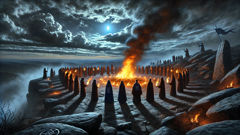
They passed through groves where owls watched silently from twisted branches and across streams that flashed silver in the moonlight. Every so often, a witch would stoop to gather herbs or scatter a handful of seeds, whispering blessings for spring’s return. Liese’s heart beat faster with each step. She felt herself changing—no longer an outsider, but a thread woven into something vast and mysterious.
As they neared the summit, a chill wind rose. The trees thinned and gave way to a stony plateau littered with boulders and gnarled roots. In the distance, a faint line of torches flickered—a procession of villagers, led by the priest and elders, winding up from Wernigerode in hopes of driving away evil with prayer and song. Between these two worlds—witches and villagers—Liese walked alone, her mind torn between loyalty and longing.
Suddenly, the old witch halted and laid a hand on Liese’s shoulder. “Look,” she said softly. On the bare stone ahead, a gathering unlike any Liese had ever seen was forming. Witches from every corner—young and old, bold and shy—converged in a great circle. Some wore crowns of wildflowers; others bore staffs carved with runes. Overhead, clouds swept across the moon, casting shifting patterns of light and shadow.
The witches began to chant, their voices rising and falling like wind through pines. Flames leapt higher from a central pyre, illuminating their faces—some lined with centuries, others smooth as spring leaves. In their midst stood the old witch, her hair streaming silver in the wind. She lifted her staff, and the chanting swelled. The very air seemed to vibrate with power.
Then, from the darkness at the edge of the circle, a figure emerged—a man clad in dark robes, eyes glittering with malice. The old witch’s smile vanished. “He comes every year,” she whispered to Liese. “A spirit of winter’s hold—here to challenge spring’s return.”
The villagers’ procession had reached the plateau’s edge now, their torches flickering uncertainly. The wind howled, scattering sparks into the gloom. The man strode into the firelight, his voice cold as ice. “You think your little dances can banish me? Winter’s grip is strong. I’ll see your valley wither.”
For a moment, fear swept through the witches’ ranks. But Liese, remembering her mother’s pale face and the hope that had brought her this far, stepped forward. She raised her father’s cloak—embroidered with protective runes—and faced the spirit.
“My people have survived every winter,” she said, her voice steady despite her trembling hands. “We remember loss, but we choose hope. You have no power here tonight.”
The witches took up her cry, their voices ringing clear and strong. Fire flared, wind roared—and the spirit shrank back, his form dissolving into mist as dawn’s first light crept across the sky. The witches cheered, gathering Liese into their circle. The old witch pressed a vial of healing herbs into her hand. “For your mother,” she murmured. “And for your courage.”
III. Dawn and the Dance of May
As the spirit of winter faded into the morning mist, a hush settled over the mountain. The witches’ circle loosened, their tense faces relaxing into smiles. One by one, they knelt to gather dew from the stones and herbs from the thawing earth, whispering blessings into the wind. The villagers, seeing that no harm had come to Liese and that the witches’ revels had not brought ruin but renewal, set down their torches and approached hesitantly. The priest’s voice trembled as he addressed the old witch. “Is it truly over?”
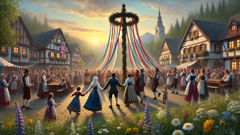
The old witch smiled kindly. “Only for this year. Each spring we must choose hope over fear.” She beckoned Liese to her side. “This child has shown us all that courage bridges worlds.”
A murmur of agreement ran through both groups. Liese turned to see her friend Jakob—who had followed the procession out of worry—stepping forward. He offered his hand. “Will you dance the Maypole with us?” he asked shyly. The old witch nodded in approval, and together witches and villagers descended from Brocken’s heights into the waking world below.
In Wernigerode, the May Day festival burst into color. Ribbons fluttered from the maypole, children ran laughing through fields of wildflowers, and music filled the air. Liese’s mother—restored by the witches’ herbs—stood in the sunlight, her cheeks blooming with health for the first time in months. The old witch and her sisters watched from the edge of the square, their eyes twinkling with secrets.
As night returned and stars kindled above, Liese wandered to the edge of the village, where the first green shoots curled through the last of winter’s frost. She knelt, pressing her palm to the earth in gratitude. The mountain loomed against the sky, its slopes quiet now, but she could still feel its ancient heartbeat—the memory of firelight and song, of courage found and darkness faced.
Walpurgis Night became more than a tale told to frighten children; it was a memory etched into every stone and tree. Each year, villagers remembered Liese’s courage—the night she walked between worlds and brought hope home. And when the wind howled through the pines or laughter echoed from the Brocken’s summit, all who heard it knew: spring would always return, so long as there were those brave enough to meet the night and welcome the dawn.
Conclusion
The legend of Walpurgis Night endures in every whispered tale and every hopeful heart that faces darkness. On the Brocken’s wild slopes, witches still gather—or so the old stories say—chasing away the chill of winter with laughter, courage, and song. For Liese and her village, that fabled night became a turning point: proof that what we fear is often softened by understanding, and that unity is the surest magic of all. Each year, as April faded and May beckoned with its promise of renewal, the people of Wernigerode hung herbs above their doors and greeted their neighbors with kindness. In their dances around the Maypole, they remembered that even the deepest shadows can be broken by a single spark of hope. And so the Brocken remained both a place of mystery and a symbol of new beginnings—where the boundaries between worlds blurred, and courage shaped the dawn.

